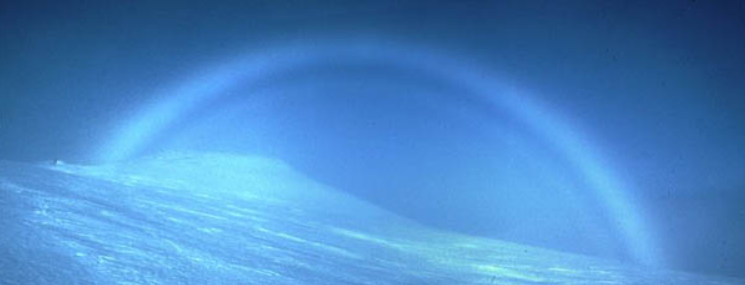Fogbow
Fogbow: The Ghostly White Bow in the Mist
When the conditions are just right, a mesmerizing phenomenon known as a fogbow can appear in the sky. Similar to a rainbow, a fogbow is formed by the interaction of sunlight with water droplets in the air. However, there are some fascinating differences that set fogbows apart from their colorful counterparts.
What is a Fogbow?
A fogbow, also known as a white rainbow or ghost rainbow, is a faint and colorless optical phenomenon that occurs when sunlight interacts with tiny water droplets suspended in fog or mist. Unlike rainbows, which are formed by the refraction, reflection, and dispersion of light in raindrops, fogbows are created through a process called diffraction.
The Science Behind Fogbows
Fogbows are formed when sunlight encounters water droplets in the air that are smaller than raindrops. These tiny droplets diffract the light, causing it to spread out and form a wide arc in the sky. The lack of color in fogbows is due to the fact that the water droplets are so small that they do not effectively separate the colors of light like raindrops do.
The Appearance of Fogbows
Fogbows are typically larger than rainbows and have a fainter appearance. They often appear as white or pale arcs against a backdrop of fog or mist. Unlike rainbows, which can display a full spectrum of colors, fogbows usually appear colorless or with very subtle pastel shades. Occasionally, faint supernumerary arcs may be visible within the main bow, adding an extra touch of ethereal beauty to the phenomenon.
How to Spot a Fogbow
To witness a fogbow, you need to be in the right place at the right time. The ideal conditions for fogbows to form include:
- Presence of fog or mist
- Sunlight shining from behind you
- A clear view of the fog or mist
- The absence of rain or heavy precipitation
The Formation Process
When sunlight passes through the tiny water droplets in fog, it undergoes diffraction, causing the light to bend and spread out. As a result, a fogbow appears as a wide arc in the sky. The size and intensity of the fogbow depend on several factors, including the size and distribution of the water droplets.
The Role of Droplet Size
The size of the water droplets in the fog plays a crucial role in determining the appearance of a fogbow. Smaller droplets result in a larger and more distinct fogbow, while larger droplets may lead to a less defined and fainter bow. The diameter of the water droplets typically ranges from about 10 to 100 microns.
Fogbow Simulation
To gain a deeper understanding of fogbows, scientists use simulations to replicate the phenomenon. By manipulating variables such as droplet size and distribution, they can recreate the intricate patterns observed in fogbows. These simulations help explain the formation of supernumerary arcs within the main bow and provide insights into the physics behind this captivating atmospheric optics phenomenon.
Capturing the Beauty of Fogbows
Photographing a fogbow can be challenging due to its subtle appearance and the need for specific atmospheric conditions. However, when successfully captured, fogbow images can evoke a sense of awe and mystery. The ethereal white bow, surrounded by a misty backdrop, creates a hauntingly beautiful scene that showcases the wonders of nature.
Fogbows Around the World
Fogbows can be observed in various parts of the world where conditions are favorable. From misty mountaintops to coastal areas engulfed in fog, these ghostly white bows have been documented in different landscapes. Some notable locations for witnessing fogbows include Scotland, Ireland, coastal regions of California, and the foggy valleys of New Zealand.
In conclusion, fogbows are captivating optical phenomena that occur when sunlight interacts with tiny water droplets suspended in fog or mist. With their ethereal white appearance and subtle pastel shades, fogbows offer a mesmerizing spectacle for those fortunate enough to witness them. Understanding the science behind fogbows and capturing their beauty through photography allows us to appreciate the intricate wonders of the natural world.

A ghostly white bow shines from mountain fog on Carn Gorm, Scotland. This spectacular fogbow was photographed by Simon Caldwell (site) in February 1999. The matching IRIS simulation shows that the fog droplets were ~60 micron diameter. Photo ©Simon Caldwell.

The Mie scattering simulation used a mean droplet diameter of 60 micron with a lognormal distribution of diameters having a standard deviation 12% to match the width of the primary fogbow and the position of the two supernumerary arcs inside the main bow.
Note: this article has been automatically converted from the old site and may not appear as intended. You can find the original article here.
Reference Atmospheric Optics
If you use any of the definitions, information, or data presented on Atmospheric Optics, please copy the link or reference below to properly credit us as the reference source. Thank you!
-
<a href="https://atoptics.co.uk/blog/fogbow/">Fogbow</a>
-
"Fogbow". Atmospheric Optics. Accessed on April 25, 2024. https://atoptics.co.uk/blog/fogbow/.
-
"Fogbow". Atmospheric Optics, https://atoptics.co.uk/blog/fogbow/. Accessed 25 April, 2024
-
Fogbow. Atmospheric Optics. Retrieved from https://atoptics.co.uk/blog/fogbow/.